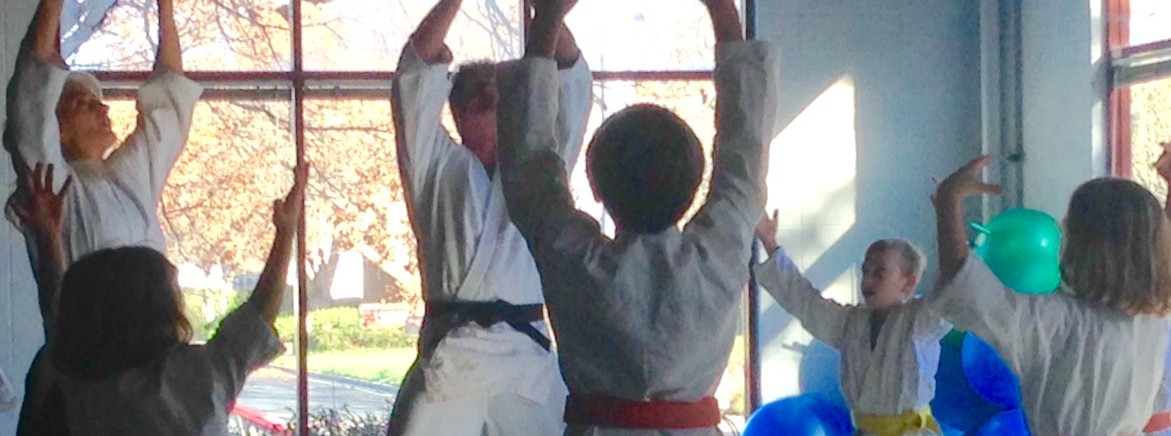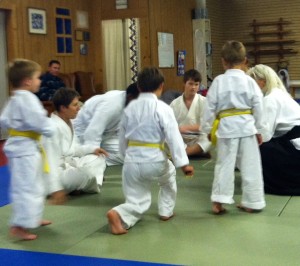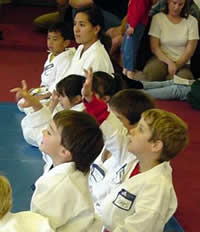e | Details
PHILOSOPHY / GOALS
Aikido of San Luis Obispo’s Youth Program is committed to teaching non aggressive, developmentally appropriate methods of self-protection that are practical and empowering. This program teaches children how to use the principles of Aikido and generalize them to the kinds of situations they face in their everyday lives.
The method of training is non-competitive, so that self-worth is based on an internal sense of power and safety, rather than on a need to defeat others in order to achieve success. Realistic, developmentally appropriate safety skills-that do not induce fear or a desire to ‘show-off’ are offered in the context of a sincere commitment to non-violence.
 Aikido nurtures a caring attitude toward self and others. Children are taught to connect with and redirect a partners energy so that conflict and physical injury can be prevented. There are never any losers or “opponents” in Aikido; partners are the people who enable you to practice and learn about yourself and your body’s natural power. Thus, while children learn specific physical techniques, they are learning them within a philosophy which holds that one’s goal is to stay safe and not hurt others.
Aikido nurtures a caring attitude toward self and others. Children are taught to connect with and redirect a partners energy so that conflict and physical injury can be prevented. There are never any losers or “opponents” in Aikido; partners are the people who enable you to practice and learn about yourself and your body’s natural power. Thus, while children learn specific physical techniques, they are learning them within a philosophy which holds that one’s goal is to stay safe and not hurt others.
This Aikido principle of keeping safe and not hurting others is explored and sometimes role-played in class. For example, when a school yard bully threatens a child, the child’s first reaction may be either to recoil into submission or to lash out in revenge. (Aren’t these the two primary responses to conflict seen in the media?) Aikido encourages more humane alternatives: de-escalating the situation with voice and body language in an empowered, respectful way; moving the body efficiently to avoid an oncoming punch; leaving the situation with a centered awareness and telling parents or other safe adults.
We use training, exercises, and games to develop mindful awareness, balanced strength, grounded body positioning, focused energy and attention, coordination, verbal and non-verbal boundaries, and cooperative interpersonal skills. Some youth have more interest in practicing the actual Aikido techniques, other young people enjoy the focus on tumbling safely, body-space awareness, gross motor control, voice power, or being in the context of creative-thematic play, imagination games, and small group learning.
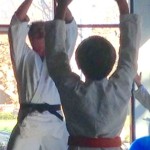 HEALTHFUL ENERGY RELEASE
HEALTHFUL ENERGY RELEASE
Aikido training for children involves certain principles that involve safety and ensure a growthful, respectful, and playful learning environment. For example, children are experientially taught the difference between “focused” and “unfocused” or “centered” and uncentered” behaviors. What is considered to he “focused energy and attention” for older kids very different than what is expected for the younger children. Likewise, depending on age and other factors, kids will have a surplus of energy on the mat. Rather than attempting to suppress a child’s energy we communicate Aikido principles within the context of high-energy games that healthfully release surplus energy.
NON-OPPRESSIVE DISCIPLINE
When behavior becomes inappropriate or distracting to the group the child receives a gentle and clear reminder by the teacher. 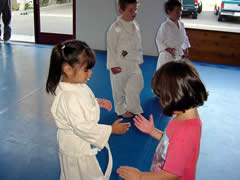 After a “reminder” or “warning,” the child may directed to sit quietly off the mat to think about if she or he “really wants to do Aikido today.” While focus and self-discipline are encouraged, we do not believe in pressuring a child into fear-based approval-seeking behaviors, such as doing a class when they do not feel like participating. Finally, all children have “bad” days; and, all children, even when engaging in disruptive behavior; are provided with consistent affirmations of their inherent value and goodness. The goal is for children to feel a sense of unconditional acceptance, even (and especially) when boundaries are being set.
After a “reminder” or “warning,” the child may directed to sit quietly off the mat to think about if she or he “really wants to do Aikido today.” While focus and self-discipline are encouraged, we do not believe in pressuring a child into fear-based approval-seeking behaviors, such as doing a class when they do not feel like participating. Finally, all children have “bad” days; and, all children, even when engaging in disruptive behavior; are provided with consistent affirmations of their inherent value and goodness. The goal is for children to feel a sense of unconditional acceptance, even (and especially) when boundaries are being set.
CENTER / FOCUS
In Aikido, we learn how to attain a feeling of centeredness. More importantly though, we learn how to regain that feeling when we lose it. As adults know, to become centered and focused (whether we are on the mat, at home. or at work) may require subtle shifts in perspective, attitude, body posture, or not-so-subtle shifts in how we communicate with our loved ones or give ourselves a “time out” to reflect and reassess our expectations. Children who are in the midst of a scuffle over ‘whose hall it is’ or ‘who shoved whom first’ can he guided by the teacher to use this ‘moment’ of internal and external discord as an opportunity to practice negotiating a peaceful resolution on an interpersonal level. The point of studying Aikido is not just to learn to keep centered all the time; rather, it is how one transitions back to center from a place of discord.
UNSTRUCTURED PLAY BEFORE CLASS
Students of every age group may run onto the mat before class (with permission from the instructor) with exuberance and enthusiasm for unstructured play. During this time they may run around catching and throwing balls, chasing each other; yelling, laughing, dodging, and rolling. This spontaneous play has its benefits. It allows young people to burn off extra energy as they prepare for structured learning, to ‘unconsciously’ practice adjusting their bodies to avoid collisions with others in a specific space (the mat) and to blend their tumbling and movements in a free form, self-protecting way.
COLLISIONS
Occasionally, even in the structured context of class, a child isn’t paying attention and a collision occurs. Sometimes laughing is replaced with tears. While seemingly chaotic, these times are often the most “teachable moments” in which the Aikido principles of self awareness, respect, heartfulness, honesty, and learning from ‘mistakes’ are explored.
PROMOTIONS / RANK
There are no tournaments or competitions in Aikido. In keeping with the cooperative Spirit taught by Aikido Founder, Morihei Ueshiba, students do not achieve higher rank by ‘beating’ others. Instead, promotions occur through demonstrating proficiency with specific techniques and principles.
Typically, the instructor determines when a student is ready to demonstrate, and sets a date that the child can work toward. Parents are always invited and welcome to attend and celebrate their child’s accomplishment. Because promotion / rank is never encouraged at the expense of enjoying or appreciating the study of Aikido, students are never forced to demonstrate. The process should he a challenge that inspires a child toward a goal, rather than a stressful event that invokes fear/anxiety of failure or inadequacy Parents are invited to communicate with the instructor about this process at any time.
